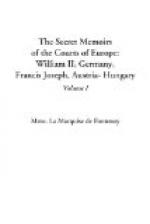Far more polite was Emperor Napoleon III. when at a Tuileries ball a middle-aged officer and his fair partner came to grief. As the mortified warrior scrambled to his feet, the emperor extended a hand to help him, and turning to the lady, remarked:
“Madame, c’est la deuxieme fois que j’ai vu tomber monsieur le colonel. La premiere fois c’etait sur le champ de bataille de Magenta.” (Madame, this is the second time I have seen the colonel fall. The first time was on the battlefield of Magenta.)
In order to see the Polonaise danced in all its glory, it must be witnessed on the occasion of the wedding of some princess of the reigning house of Prussia, when the dance is headed by a procession of cabinet ministers, bearing candles or torches, whence it is styled the “Fackel-tanz,” (Torch-dance).
On such an occasion the emperor, the empress and the royal guests having taken up their places on the dais, under the baldaquin, and immediately in front of the throne, the less exalted guests ranging themselves to the right and left of the great white hall, according to rank and precedence, the court marshal receives orders from his majesty for the dance to begin. The count thereupon approaches the royal bride and bridegroom, and bowing low to them, invites them to take part in the dance. The bridegroom extends his hand to his consort, and to the sound of a very slow and stately march conducts her around the hall, preceded by the twelve ministers of state, walking two by two, those highest in rank coming last. Each, minister bears in his hand a lighted torch of white perfumed wax. When the procession returns to the point from which it started, in front of the throne, the bride approaches the emperor, and with a curtsy invites his majesty to take part in the dance, and is conducted around the room by him, the bridegroom going through the same formality with the empress. As soon as these first three rounds are concluded, the twelve ministers hand over their wax torches to twelve pages of honor, each lad being of noble birth, and the bridegroom then similarly invites the remaining princesses of the blood, two at a time, leading one with each hand, while the bride goes through the same procedure with two princes of the blood, until the total list of royal personages has been exhausted. When the number of royal guests is very large this dance sometimes lasts nearly two hours.
On ordinary cases, of course, the torches are dispensed with, and the polonaise only continues long enough to enable the emperor and empress to march once round, the hall with those guests whom they wish particularly to honor. On such occasions they are preceded by the court marshal bearing the wand of grand marshal, by several masters of the ceremonies, and by picturesquely attired pages of honor.




